SMITHSONIAN CENTER FOR FOLKLIFE & CULTURAL HERITAGE
West Virginia’s Mothman Leads Cryptid Renaissance
The creature has risen from local appearances to the national stage as a leader in the cryptid revival of the last twenty years.
:focal(600x400:601x401)/https://tf-cmsv2-smithsonianmag-media.s3.amazonaws.com/filer_public/44/69/4469d93f-8fc3-4ae7-85f7-f82d285fb58a/mothman-red-eyes.jpg)
The town of Point Pleasant, West Virginia, offers its residents a landscape once claimed for France by a seventeenth-century explorer, a namesake battle site many swear is the first of the Revolutionary War, and a bipedal, humanoid, mothlike creature with glowing eyes. The last of these local treasures is, of course, extraordinary.
Lovingly dubbed “Mothman,” the creature has risen from local appearances to the national stage as a leader in the cryptid revival of the last twenty years. Cryptids—creatures whose existence is unsubstantiated, like Bigfoot and the Loch Ness Monster—are found in folklore throughout the United States and the world. The cryptid comeback not only brings exciting mysteries into the lives of outsiders but promotes pride of place to the residents of towns like Point Pleasant.
According to competing theories, it was here on November 15, 1966, that Mothman emerged from either the depths of hell or the upper echelons of space. Roger and Linda Scarberry and Steve and Mary Mallette were driving together on State Route 62 near the abandoned National Guard Armory building and power plant when they saw a menacing figure standing six to seven feet tall. In the headlights, giant eyes shone bright red. Panic set in. Roger, the car’s driver, sped away toward town.
But the creature followed. According to these first eyewitness accounts, the “thing” rose up like a helicopter. Though a “clumsy runner” as they saw at the power plant, it excelled in gliding, easily keeping pace, even as the car reached a hundred miles per hour.
The creature’s debut ruffled the town’s feathers, making for an unsure headline the next day in the Point Pleasant Registry: “Couples See Man-Sized Bird...Creature...Something.” The stereotypical inclination for a small town to form an angry mob heightened. Rather than raising pitchforks and torches, for several nights, curious townspeople made hunting rifles their preferred weapon.
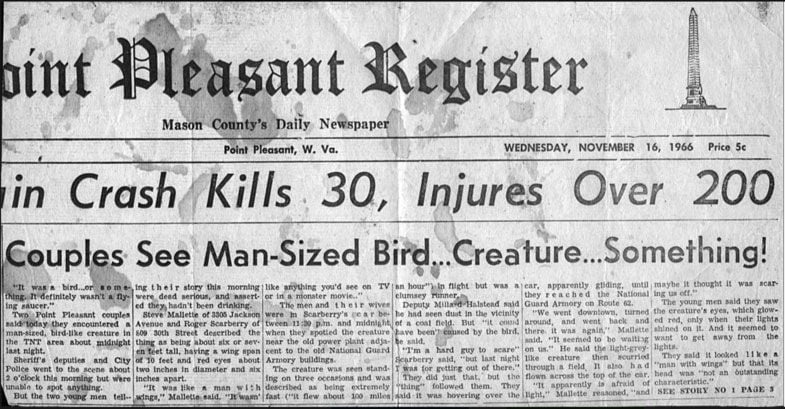
With this initial contact, and according to written reports, Mothman would be responsible for a host of strange sightings and events in Point Pleasant and the surrounding areas—lurking outside homes, chasing cars, and stealing pet dogs.
Stealing dogs? The day before Mothman stretched his leathery wings above the couples’ car, it’s possible he made a stop at Newell Partridge’s home in Salem, West Virginia. This account, chronicled in John Keel’s book The Mothman Prophecies (1975), tells of a German shepherd named Bandit who bolted into the woods after two glowing red circles. Partridge says he looked for Bandit, but found nothing but paw prints going in circles and then vanishing. We’ll never know if this was the true birth of Mothman’s story—two glowing circles may not a Mothman make. But Bandit’s story would never have surfaced without the frightening tale of the Scarberrys’ close encounter.
Mary Hyre, a journalist with the Athens Ohio Messenger—the local news source for the northern neighbors of Point Pleasant—found herself covering these strange sightings and encounters. Her first article, entitled “Winged, Red-Eyed ‘Thing’ Chases Point Pleasant Couples Across Countryside” appeared without delay on November 16, 1966. She joined forces with bigshot New York paranormal journalist, John Keel, for his previously mentioned work, The Mothman Prophecies. This nonfiction record of the odd occurrences, and the subsequent 2002 film which starred Richard Gere, would launch Mothman and the West Virginia town onto the national stage.
But by the time of the movie’s premiere, Point Pleasant itself had lost direct sight of Mothman. The creature had laid low since the deadly collapse of the Silver Bridge in December 1967. Many saw no connection in an alleged sighting just before the collapse, while some viewed Mothman as a sinister harbinger of doom.
Since then, Mothman seems to have kept to himself—until recently. In 2019, accounts of a flying moth creature in Chicago stoked the paranormal creature craze. But as he makes national news once again—an NPR inquiry was entitled “The Case Of The Chicago Mothman”—lovers of the unknown and the unsubstantiated should remember exactly where his roots lie, and where a twelve-foot-tall statue of his likeness by Bob Roach stands: Point Pleasant.
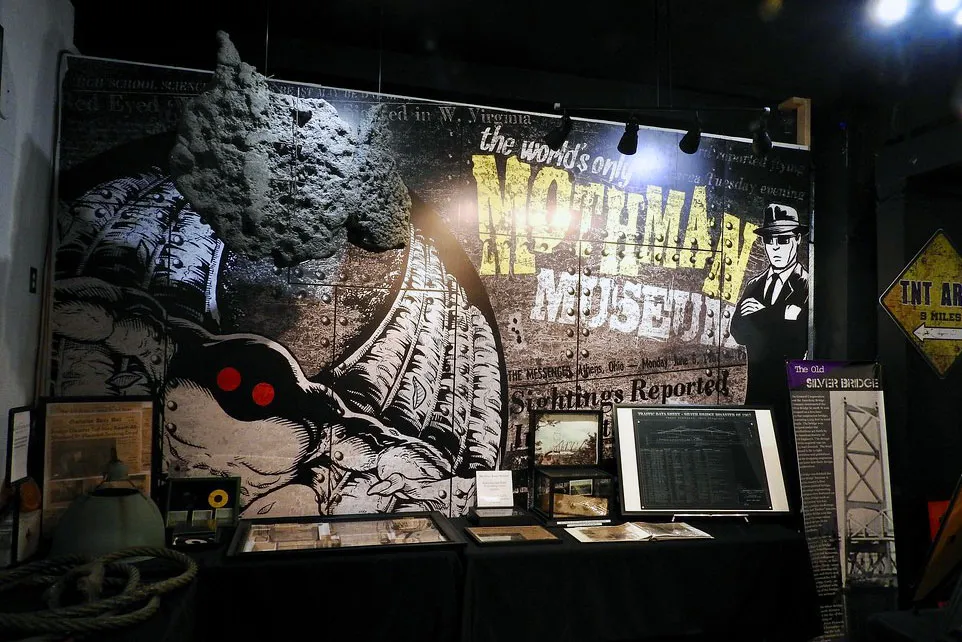
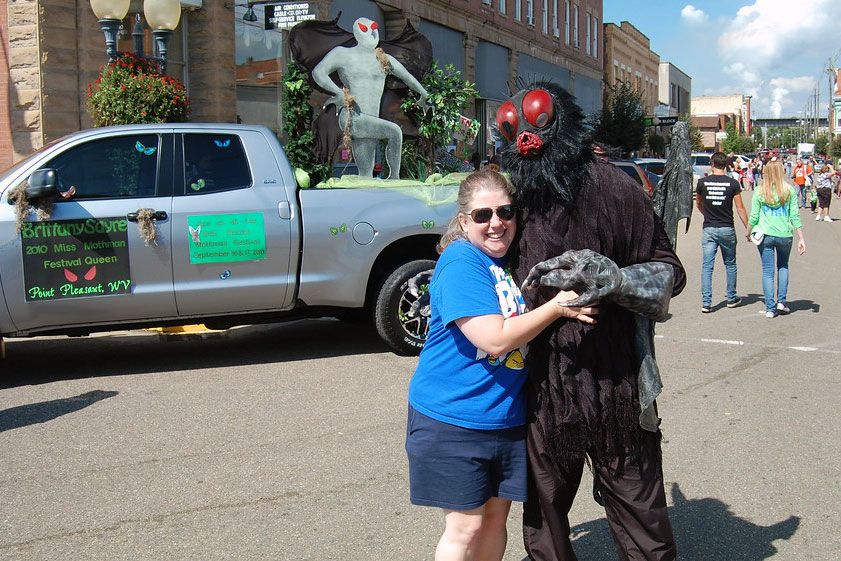
From the story of Mothman, one can learn the importance of hometown, homegrown heroes of the dark woods and the roads less traveled. In 2006, Jeff Wamsley, a Point Pleasant native who grew up listening to the stories—his father worked at the National Guard Armory—opened the Mothman Museum to showcase all the archival material he had assembled. The collection features police reports and witness accounts from various sightings. Though he was just six years old when Mothman bewildered the people of Point Pleasant the first time, Wamsley released two books on the subject through Mothman Press: Mothman: Facts behind the Legend in 2001 and Mothman: Behind the Red Eyes in 2005.
Wamsley’s museum offers Mothman history and produces an annual festival, which grows in attendance each year. Had it not been for the pandemic in 2020, Wamsley estimates that Point Pleasant would have again welcomed crowds totaling over 15,000, a staggering influx for a town with fewer than 5,000 residents. Mothman finds his way onto T-shirts, local café cookies, and Etsy shops.
“I think the Mothman story is timeless,” Wamsley says. “It’s never been fully solved or proven as to what these people were seeing. People come here to see for themselves and to investigate on their own, to make up their own minds. Everyone has their own theory. It’s a part of the town’s history.”
Rosemary Hathaway, an associate professor of English at West Virginia University, defines the revival of cryptid-mania as a “renaissance.” At the heart of the comeback of Mothman—and his West Virginian cryptid contemporaries like the Sheepsquatch and the Flatwoods Monster—is a bubbling sense of pride and a resurgence of traditional storytelling by and for small-town residents. Historically, West Virginia’s identity has been defined to outsiders by its extraction industry.
“If they do know about West Virginia, they tend to have stereotypes: Cletus the Slack-Jawed Yokel and a miner,” says Hathaway, the daughter of two West Virginia natives and WVU alumni. By introducing their legends to outsiders, they’ve made an advantageous grab for financial gain and invented a new way to educate and engage tourists.
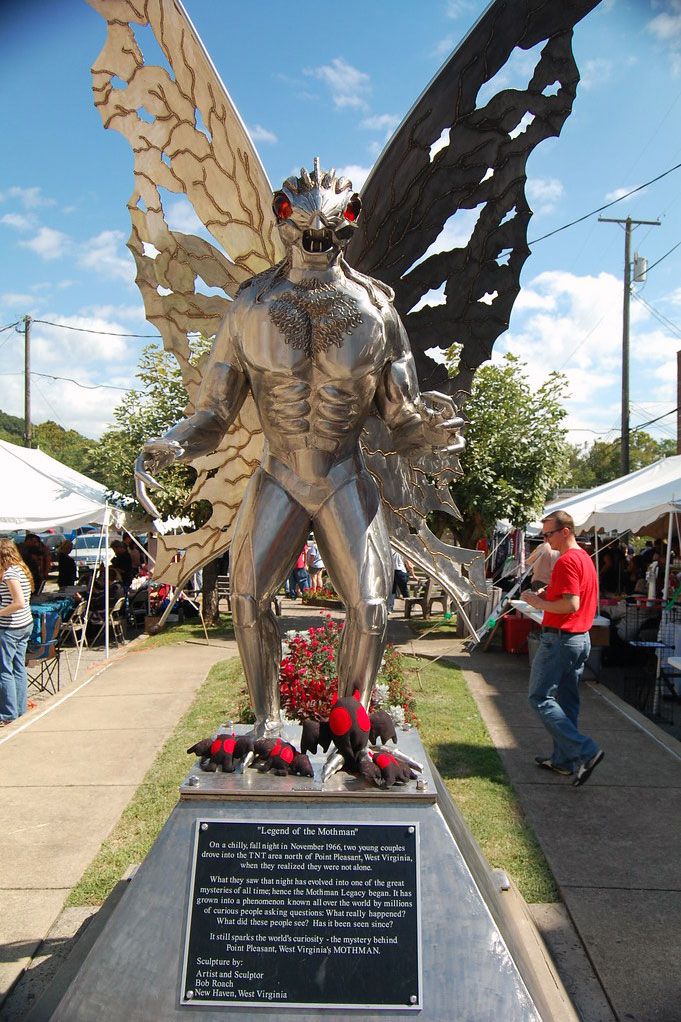
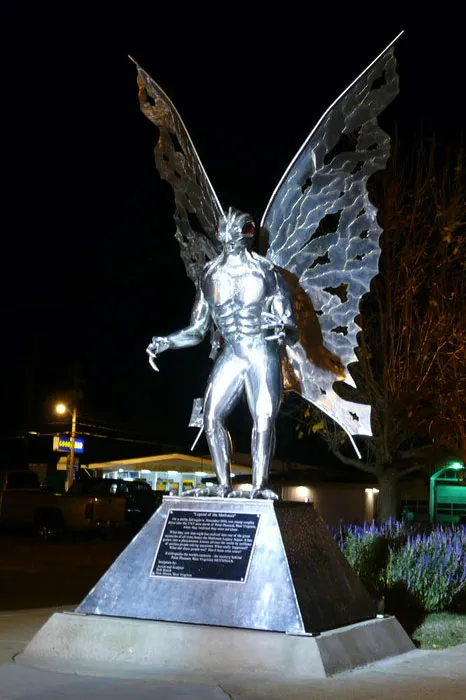
As a folklorist and educator, Hathaway notes the disconnect between the stereotypes and the cultural significance of stories like Mothman.
“There definitely is a long storytelling tradition in West Virginia, and I think it tends, historically, to follow along two lines: either it’s tall tales or a long tradition of ghost stories and the supernatural and weird things happening in the woods. That sort of thing. My sense is that cryptid stories are the more modern versions of ghost stories.”
According to Hathaway, ghost stories and weird things in the woods exist as cautionary tales, and, in some cases, as indicators of the respect small-town people have for the natural world.
Kim Stryker, who teaches folklore at George Mason University, reckons this supernatural interest springs up in society when a distraction is needed. The last twenty years, she says, have meant unprecedented challenges to everyday life, and that in periods of great political and societal upheavals, stories like that of Mothman are greatly welcomed.
“People seek out evil in history to, in a way, ‘inoculate’ themselves from scary or terrible events,” Stryker mentions, explaining the allure of “dark tourism,” or why people intentionally vacation in places associated with paranormal events or true crime.
Hathway believes that stories like Mothman show that there is “something of value in West Virginia,” and praises the people of small towns for taking advantage of the strange phenomena of the deep woods and tall mountains. “There’s money to be made with these cryptids, and I am glad they’re doing it!”
Point Pleasant has become a prime destination for dark tourism. As many locals tell it, the story of Mothman goes beyond the alleged sightings, spilling into mentions of Men in Black, extraterrestrial lifeforms, and conspiracy theories. Tourists are offered the chance to solve the mystery of the anomalous being and take home special Mothman memorabilia, crafts, and pastries from the museum, shops, and cafés of Point Pleasant’s downtown district.
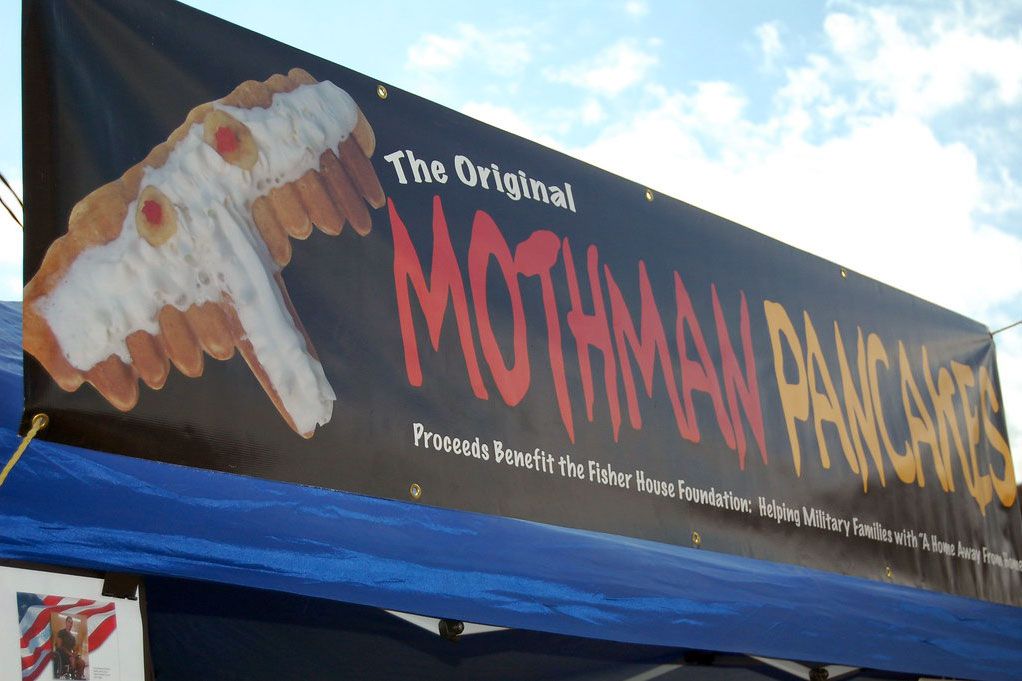
While outsiders theorize about the existence of Mothman, Point Pleasant natives like Wamsley pour themselves wholeheartedly into the famous cryptid, considering it alongside the rich historical heritage of their hometown.
“It’s also a great way to introduce visitors to Point Pleasant’s rich river and cultural history—lots of neat shops on Main Street and some interesting places and things to see added to the Mothman experience,” he says.
The caverns, mountains, and hollers of West Virginia are no stereotype; they house intriguing characters made resident in storytelling and supernatural American folklore. And true or not, one can unearth rich meanings in cryptids that tempt us to tell their tales. Our fears feed this process too. When a child sits cross-legged on the ground to hear the reasons that they should never go into the abandoned power plant, what better way to bring the point home than a giant flying moth creature? And as those same kids grow into moody adolescents, and then to young adults, seasoned humans, and slope into elder storytellers themselves, legends like Mothman, told in the authentic Appalachian drawl, serve as sources of identity, memory, and place.
While Mothman is one of the most celebrated cryptids—let’s say the Michelangelo of the Appalachian cryptid Renaissance—there are numerous legends in the small towns of West Virginia. Or perhaps readers from other places may be reminded of their own hometown folktales and legends. So, take this as an ode to the spooky stories of small towns across America—from the witches of Salem to the Jersey Devil to La Llorona, historic or cautionary tales, angels or devils—let them stand as meaningful, even validating, and bask in the natural sense of enchantment that emanates from the mysterious.
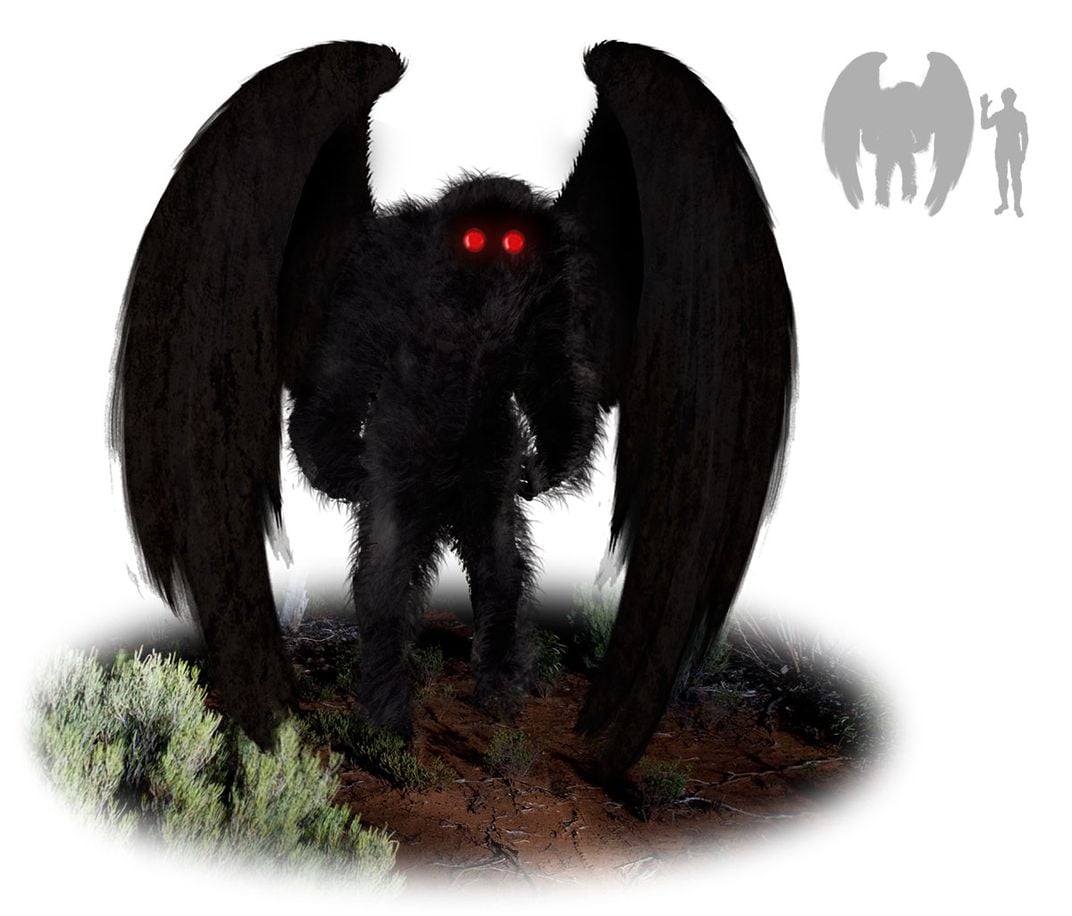
Gwen Mallow is an intern at the Center for Folklife and Cultural Heritage and a graduate of Eastern Mennonite University. She wishes to thank Jeff Wamsley, Rosemary Hathaway, and Kim Stryker for their expertise and correspondence.
